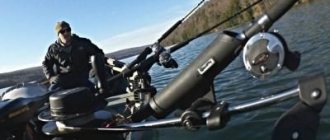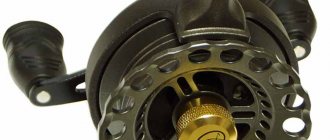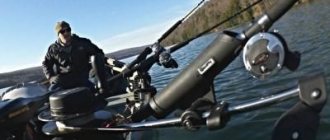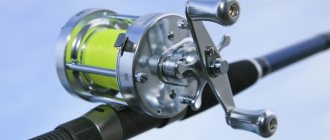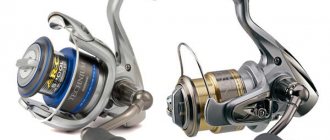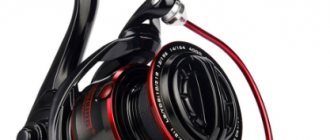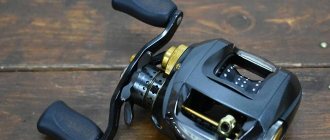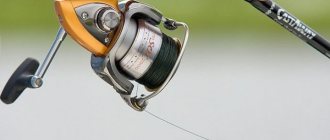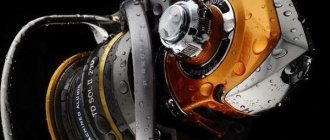- What parameters do the best spinning reels have?
- Top spinning reels for various types of fishing
- The best spinning reels for spinning rods rating of brands
- Rating of spinning reels for jigs: the best of the best
- Spinning reel for twitching rating of the best
- Characteristics, how to choose a spinning reel for a feeder
- Which spinning reel to choose for trolling - durable
- Parameters on how to choose a spinning reel for a float fishing rod
- Let's consider which spinning reel is better for jigging
How to choose a spinning reel is not an idle question for many fishermen. A well-chosen reel must meet a number of requirements: excellent balance of gear, effective retrieving, compliance with fishing conditions and size of fish, good performance when fishing.
But an equally important factor is its durability, because often the purchased device begins to disappoint the fisherman after one or two seasons. In most cases, only branded models are distinguished by the careful manufacturing and fitting of all components, considering that the number of parts in the reel is about one hundred.
What parameters do the best spinning reels have?
The choice of a spinning reel, the design of which we wrote about in the article “Fixed spool reel: winding fishing line on a spinning reel,” depends on several parameters that affect fishing efficiency:
- inertia-free size;
- spool line capacity;
- coil mass;
- number of bearings;
- friction brake location;
- gear ratio.
To understand which inertialess reel to choose, you need to start with its dimensions, on which, among other things, the power indicator depends. The so-called standard size, the step of which is 500 units, precisely characterizes its classification. Thus, size 1000-2500 is used with light spinning rods, 3000-5000 with more solid ones.
Reputable companies try to make their best spinning reels from fairly durable and yet lightweight materials, which is why models made from titanium or aluminum alloy, as well as polymers, are in use. That is, among competitors, these inertia-free vehicles will be lighter in weight.
When thinking about how to choose the right spinning reel for a spinning rod, it is worth finding out how many bearings the product has. It is due to them that the device can have a smooth running and no backlash. True, it should be taken into account that a sufficient number of bearings does not always indicate quality, because “leftist” companies put them where they are not needed.
The next characteristic that the best budget spinning reels should have is a good line laying mechanism. Today there are two of them:
- based on a crank transmission;
- laying is carried out by a worm gear.
There are also two ways to wind the line, but it is impossible to say which spinning reel is better - cross-wound or straight. The straight line ensures the laying of coils to coils, but due to failures the forest can get stuck between the coils. Cross is more reliable, but the line capacity of the spool is reduced.
If you are deciding how to choose the right spinning reel depending on the gear ratio, then you must remember that they are all divided into three types. The gear ratio is determined by the number of revolutions of the coil per turn of its handle. Power grinders are suitable for trolling or fishing for trophy specimens; high-speed ones are appropriate for fishing over long distances, for example, during a match.
The most important parameters of a spinning reel
It doesn’t matter whether you choose an inertial, inertia-free or multiplier reel for a spinning rod, do not forget to focus on the basic parameters.
Smooth and easy reel movement
You can check the reel stroke right in the store. To do this, just make a couple of quick turns with the handle and release. The reel should rotate almost silently, gradually slowing down. The smooth running of the reel most depends on the quality of the bearings; the better the bearings, the better the running of the reel. The easier the spinning reel mechanism rotates, the higher the sensitivity and comfort when fishing.
Reel size and weight
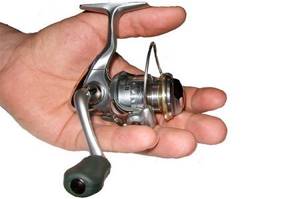
The heavier and larger the reel, the correspondingly more powerful it is. The size is usually indicated in thousands (1500, 2500, 3000). When choosing the size of a spinning reel, you need to choose a reel so that the weight and size of the reel are in balance with the fishing rod.
When choosing the size of a spinning reel, you should focus on two parameters: the size of the intended prey and the size of the bait used. For a wobbler weighing up to 12 grams, spinning reels of up to 2000 in size are suitable. For bait weighing up to 30 grams, the reel size should be from 2000 to 3500. Accordingly, for baits weighing more than 30 grams, spinning reels in sizes from 4000-5000 are suitable.
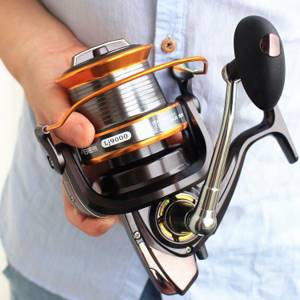
Spinning reel material
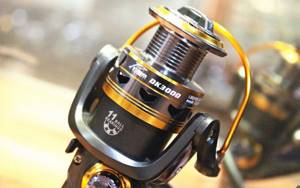
Most quality spinning reel bodies are made of metal, most often light alloys. But don’t discount spinning reels with a carbon fiber body. Some modern models are not only as strong as metal, but even surpass it. Therefore, the main guideline in this case can be considered the price! And if a carbon fiber body is not inferior in price to metal, I think it’s worth it.
You may be interested in: Fishing in Astrakhan
Spool material
Do not forget that the size of the reel also reflects the capacity of the spool. That is, how much fishing line or cord of a certain cross-section will fit on it. Spools are mainly made from three materials. These are plastic, graphite and aluminum alloys. The best material for a spinning reel spool: aluminum alloy. These spools are suitable for any type of fishing line. It is better not to take reels with plastic or graphite spools.
Spinning reel gear ratio
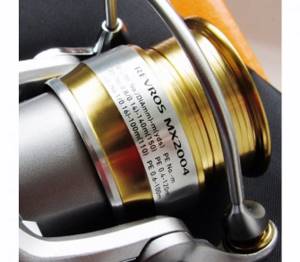
As a rule, it is indicated on the reel body. It is usually indicated on the reel body and means how many turns of fishing line are placed on the spool in one turn of the handle. The higher it is, the faster the line rewinds. But at the same time, the coil itself becomes less powerful. The choice can be made in favor of the “golden mean” - reels with a gear ratio of 5.0: 1 will be the best option, suitable for most fishing conditions.
Friction brake
The friction brake of a spinning reel is one of the most important criteria for choosing a reel. For spinning reels, it can be of two types: front and rear. Some people prefer the front, some the back. The front clutch is still more popular among anglers; many believe that it is more sensitive and reliable. It’s true that it’s difficult to say for sure which one is better, front or rear, because they work equally efficiently. Which one is more suitable for you, you will only understand during the fishing process. But the main thing, in both versions, is its correct configuration. He should release the line smoothly, without jerking.
Line laying mechanism
The gear ratio indicates how many revolutions the line layer makes in one revolution of the handle. Accordingly, the higher this number, the faster the mechanism. An indicator from 4.2 to 5.5 is considered universal.
Number of spinning reel bearings
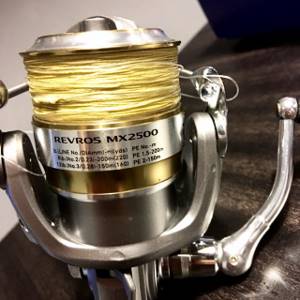
A good reel should have about five bearings, a professional one should have nine or more. The number of bearings in a spinning reel, in isolation from other characteristics, does not say anything about the quality of the reel. There is no need to chase a large number of bearings.
Top spinning reels for various types of fishing
For each type of fishing, you can create your own rating of spinning reels. As always, brands such as Shimano, Mikado, Daiwa, Salmo, Banax are at their best. The rods produced by these companies have excellent characteristics.
The best spinning reels for spinning rods rating of brands
Daiwa Sweepfire X
. Budget spinning reels are topped by this model. Very durable and of good workmanship. Designed for fishing on monofilament thread with uniform fishing. True, there is a minus - the quality of the line winding suffers, and besides, it contains one bearing.
Daiwa Megaforce A
. At first glance, the heavy reel has excellent ergonomics and remarkable qualities. The mechanism is equipped with five bearings and has a reverse stop. Suitable for fishing with monofilament and braided line.
Shimano Nasci13 HG
. Included in the rating of manufacturers of spinning reels. Due to the flat body it is easy to distinguish among competitors. Supplied with an aluminum spool. The scaffolding roller is made with a bend, due to which scaffolding overlaps behind it are minimal.
Okuma Artics RTX
. With eight bearings it has a low mass. The rotor is made of graphite, all other components are made of aluminum alloys, which together gives a soft ride and long-term operation. It is included in the rating due to a special mechanism that protects the clutch from moisture and abrasives.
Daiwa 10 Revros MX
. The review of spinning reels is completed by a very light model with a planetary laying system. Equipped with four bearings. Different modifications differ in gear ratio. But, according to fishermen, there is a slight backlash that cannot be eliminated.
Rating of spinning reels for jigs: the best of the best
Jig fishing involves the use of not only inertialess meat grinders, but also multipliers. It is believed that if the mass of the bait does not exceed fifteen grams, then it is more comfortable to fish with a spinning rod, although there are models that work well with large weights.
DaiwaCertate Hyper Custom 3000
.
The best spinning reel with an appropriate price. The mechanism is securely protected from moisture and sand and has twelve bearings. Very light spool with titanium sides. With a small weight it has sufficient power. Ryobi Excia MX 3000
. The model is more intended for professional fishing. With nine bearings it has a gear ratio of 4.9:1. The clutch is located at the front of the body; depending on the cross-section of the line, the spool capacity reaches up to 300 m. A spare spool is not provided. It is one of the top spinning reels for budget class spinning rods.
Shimano Twin Power 4000 PG
. It is considered a powerless inertia-free vehicle, the gear ratio is 4.2:1. It has very powerful characteristics, thanks to which it can withstand heavy loads. Most suitable for heavy jigs.
DaiwaTD-SOL
. It cannot be said that it is included in the rating of inexpensive spinning reels, but the price is quite acceptable for its class. Aluminum body and reverse taper spool. Front clutch with decent sensitivity. Gear ratio – 4.7:1, seven bearings. The kit includes an additional spool.
Shimano Biomaster FB
. The inertia-free plant easily tolerates sea water. Quite a powerful meat grinder with smooth running. Seven bearings, gear ratio – 5.2:1. The scaffolding is wound on the drum in a cross way.
Spinning reel for twitching rating of the best
The top 10 best spinning reels have been compiled above. Let's try to add a couple more meat grinders, whose purpose is twitching. With this method of fishing, the bait either keeps the line in tension or loosens it, which as a result leads to the formation of beards and the dropping of loops. This is why twitching requires a meat grinder with good scaffolding.
SHIMANO TWIN POWER 15 2500S
. Heads the review of spinning reels. This device is a premium one. It has incorporated the maximum of advanced and innovative developments. Features include rugged design, water resistance and amazing power.
Ten bearings make the operation of all mechanisms smooth and soft. The friction brake is located at the front, and the small weight of 240 g does not disturb the balance of the gear. The gear ratio of 5.2:1 classifies the device as universal. Twelve types of coatings are applied to the elements for protection.
STINGER PRIORITY 2500
. Can be added to the top budget spinning reels due to the low cost, which does not in any way affect the excellent data. It is considered the most acceptable version for beginner fishermen, and also has good line laying.
A spare drum with a shallower depth is included. The weight is small - 245 grams, the gear ratio is 5.2:1. The reel has a fairly gentle stroke thanks to ball and roller bearings.
If we consider the rating of spinning reels for feeders, the leaders here are those manufacturers who primarily consider the reliability of these devices, capable of working with large weights. The fact is that the feeder uses feeders that need to be thrown over long distances.
Multiplier reel for spinning rod
Multiplier reels are still not very common among our fishermen, although they are very popular abroad. The popularity of these reels is growing every year and more and more anglers are no longer avoiding them. Many spinning anglers, who pick them up for the first time and make a few casts, begin to understand that even a novice angler can handle such a reel.
Description of the design of multiplier reels
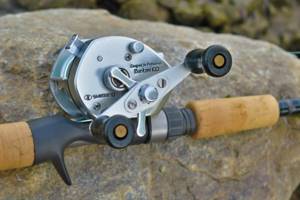
The multiplier reel is suitable for different types of fishing, with different bait weights, from the lightest to baits weighing more than 60 grams. The multiplier reel successfully combines all the advantages and disadvantages of inertial and inertia-free reels, although the design of such a reel is more complex.
The multiplier reel is a kind of modernized and improved version of the inertial reel, but in reality it is more like a compact winch. To make casting easier, there is a “trigger” located near the reel holder. Which in the lower position completely frees the spool. The reel is located close to the axis of the blank, so you can control the rotation of the spool with your finger, which allows you to make more accurate casts from different positions, avoiding tangling of the fishing line and the formation of a “beard”, plus it provides better tactile sensitivity through your fingers.
In the upper position of the “lever” the spool is clamped as much as possible, and in order for the clutch to work, effort must be made. In the middle position, the “lever” snaps into place. This zone is usually used at maximum loads on the tackle. Thus, by moving the lever, the angler will find his “golden mean” for himself.
It is better not to install a multiplier spinning reel on a regular spinning rod, it is not suitable for it, you need to purchase a casting spinning rod, it is better balanced, has the required handle length and a larger number of rings, and a reel seat that is convenient for the multiplier.

Before using the spinning reel, it is necessary to unscrew the spool and treat all elements with a napkin soaked in kerosene, thereby ridding it of excess lubricant. But in general, it is better to clean it after every fishing, this helps to increase its service life. The friction brake must be adjusted before use.
For beginning spinning anglers, in order to learn how to cast, it is still better to choose a more budget-friendly reel option. As a rule, these are low-profile reels; they are also called “soap boxes” in fishermen’s slang. But when choosing between a plastic and metal case, you should not save money and choose the second one, as it is more reliable. Low profile spinning reels have a long casting range for light lures, small diameter lines and thin braid.
You may be interested in: Favorite Professional spinning rod
Professional fishermen who practice power fishing use spinning reels with a high profile or simply a “barrel” for medium and large-sized baits. The weight of such a spinning reel can reach 1500g. They can be used for sea and trophy fishing, for trolling.
Advantages of baitcasting reels
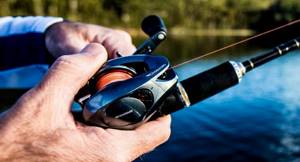
The advantages of a multiplier reel are obvious:
- Design reliability
- High power, which is especially appreciated by sea fishing enthusiasts
- Simplicity, compactness and absence of unnecessary parts
- High sensitivity and control over the line during fishing
- Ease of use
Disadvantages of baitcasting reels
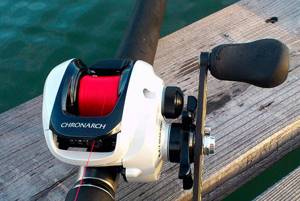
Baiting reels also have their disadvantages, which are mainly encountered by novice fishermen:
- A more complex casting technique that requires some experience and skill to do it right. Beginner fishermen especially often face this problem; they have to untangle more than one “beard” from the fishing line before mastering and practicing the correct casting technique.
- The braking system of the multiplier reel must be adjusted each time to the conditions, type of fishing, and bait used; this requires some experience.
- The price of a baitcasting reel is usually higher than that of a different type of reel.
- A baitcasting reel requires a special rod, which you will have to purchase.
- For different weights of baits, a reel of its own size is required, small reels are designed for a bait weight from 4 to 14 grams, medium-sized reels are designed for all baits up to 40 grams, heavy reels are designed for a bait weight of 60 grams or more. When buying a medium-sized universal baitcasting reel, you may have problems casting light-weight lures.
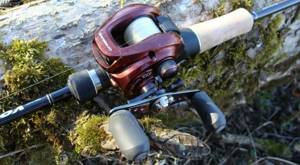
What is the difference between an inertial coil and an inertialess coil in principle?
Despite the centuries-old hobby of fishing, the reel became widely used only in the 19th century. The design was primitive: a drum with a line, equipped with a pair of small handles, was put on the axis of the body. When cast, the drum spun by inertia, hence the name.
Inertia-free systems appeared a century later and have not undergone significant changes to this day. The line comes off a stationary spool, rewinding is carried out by the line layer, which makes revolutions around it. This is briefly, if we consider inertial and inertialess coils, what is the difference.
It’s not difficult to get used to a modern meat grinder, so now the question doesn’t even arise as to which reel is better, an inertial or a non-inertial one. The advantages of the latter include a significant difference in the casting distance of the equipment and a lower risk of beard formation on the line.
What distinguishes spinning reels is the geometry of the spool, which we wrote about in the article “How to adjust a spinning reel while fishing,” and the high line laying properties. In inertial mode, the line has to be guided manually along the spool.
So, to summarize, what is the difference between a reliable inertia-free reel and an inertial one:
- Fishermen began to master the latter a century earlier.
- Inertial motors have a fairly simple design.
- They are much cheaper to purchase.
- The meat grinder is capable of very long casting.
- The likelihood of tangling the line is minimized.
Another question: how to choose inertialess fishing reels so that fishing not only becomes comfortable, but also provides a good catch. I think this topic was covered in the first part of our story.
How to choose a multiplier reel and what characteristics to pay attention to
The correct choice of cartoon depends on many factors. To extend the life of the reel, it is better to prefer a metal case, although the cost of such devices is slightly higher than plastic ones.
Modern reels have a double braking system, which we wrote about in the article “How to use a multiplier reel for spinning and its principle of operation.” One brake is activated at the beginning of the cast, when the spool accelerates sharply, the second begins to brake when the bait touches the pond.
- Magnetic braking system
. In such a system, too fast rotation of the spool is suppressed by magnets installed in the housing. Before casting, it is necessary to make adjustments based on the weight of the bait used. - Centrifugal braking system
. Multipliers of a different modification have it. Excessive acceleration is prevented by pop-up weights, which are driven by the centrifugal force generated during rotation. The reduction in speed occurs due to friction between the weights and the bushing. - Mechanical braking system
. Built into all cartoons without exception, it works at the final casting point. Its operation can be observed during long-range casting: the reel senses the increasing slack in the line and reduces the rotation of the spool.
A reel with a line stacker has good performance - a small carriage that, moving from one end to the other, evenly places the line. On the one hand, this reduces thread defects, on the other hand, the casting distance drops by 15 percent. You can choose an option with a switchable slider, in which case the friction will be reduced when casting.
If some time ago only baitcasting reels with a right-hand handle were on sale, now anglers have a choice. The main thing is to remember this at the time of purchase, otherwise you will have to relearn for a long time, and fishing will become a real torture.
Let's consider which reel is better: a multiplier or a spinning reel
There is an opinion among fishermen that a multiplier is much better than a meat grinder. It is safe to say that it is not one hundred percent true. You can’t pose the question like this: which reel is better, a multiplier or a spinning reel, since each has its disadvantages and advantages.
In addition, do not forget about what gear the fisherman has, what fish he plans to hunt and what baits he uses. Let us consider in detail whether a multiplier or a spinning reel is better.
- Multipliers are an order of magnitude higher in the price segment.
- Inexpensive meat grinders are afraid of moisture and abrasives penetrating inside.
- The inertia-free system more effectively throws off the line and reels it up. This is quite significant for a certain type of fishing.
- It is easier to throw a small bait with a spinning bait, especially if the place is unfavorable.
- The multiplier is considered more sensitive, as it allows you to feel the forest tactilely.
- The multiplier requires mastering the use of fingers in the line. The technique of casting tackle differs from casting with other reels.
- The multiplier is designed for massive baits and forceful fight against fish.
- The casting distance is affected by the diameter of the line if you have a spinning reel. With the multiplier, the difference is insignificant.
To summarize, it can be noted that the meat grinder is quite versatile, while the multi is a reliable reel that requires some professionalism. For example, on overgrown reservoirs, where it is difficult to move even along the shore, you will immediately understand the difference between a multiplier reel and a spinning reel.
Choosing a spinning reel is a delicate matter
In stores across the country you can see reels in a wide range of price ranges. I fished with reels whose cost did not exceed 300 rubles, and I also had in my hands reels from 6-7 thousand rubles. And what’s interesting is that fishing was successful in both cases. The secret is that you need to clearly understand what kind of reel you need, what fish you plan to target, what baits are in your arsenal. I have already written about the intricacies of choosing a reel, but I think it’s worth talking about which reel to choose: a multiplier or a spinning reel. For example, many fishermen already have a clear understanding of a spinning reel, and choosing among reels of this type is less difficult. But it also happens that some fishing store sellers begin to confuse the buyer by offering a multiplier to choose from. This is where the trouble begins: a person who has never fished with a multiplier does not understand where and how it can be used, whether it is worse or better than the inertialess one, what its pros and cons are. I will talk about this briefly.

Choosing the right spinning reel
It is impossible to imagine most types of fishing without a spinning reel. She takes a direct part in casting the tackle and helps well when pulling in fish, especially trophy specimens. Their designs are complex, but easy to manage. It is also necessary to understand that there are trolling models for float gear, and there are significant differences between them.
Characteristics, how to choose a spinning reel for a feeder
When using feeder fishing, it is used quite intensively, especially if you take into account the weight of the cast feeder. Braided line is often used, which reduces windage and is more susceptible to bites. All this puts a lot of stress on the spool.
Therefore, it is necessary to choose the best spinning reels for feeder that can last for several seasons. Approximate characteristics will be as follows: standard size from 3000 to 4000, gear ratio 4.5:1-5.2:1. The spool should be metal, the reverse stop should work instantly.
Which spinning reel to choose for trolling - durable
In this type of fishing, the primary criterion is strength and the ability to withstand powerful loads. This is explained by the fact that fishing is carried out for large specimens of fish. It is better to choose those models that have a recoilless brake system that is activated when cutting.
The best spinning reel for trolling should have a high-quality line roller. It will be a big plus if it is mounted on a bearing, which will somewhat reduce the twisting of the line when removing it from the water. The reel should be powered; in trolling there is no need to quickly move the bait.
Parameters on how to choose a spinning reel for a float fishing rod
The use of inertia-free fishing in float fishing provides undeniable advantages when compared with blind equipment. In this case, it is possible to fish over considerable distances and at considerable depths. The best Chinese spinning reels show good results.
When making a choice, you should pay attention to the bobbin, which should be smooth, without various roughnesses and serrations. Knowing the diameter of the monofilament used, you can select a spool with the required line capacity. Fill it so that no more than two millimeters remain to the edge of the sides to ensure free flow of the scaffolding.
Let's consider which spinning reel is better for jigging
A jig meat grinder does not have to be expensive and sophisticated. It must have the minimum required characteristics suitable for fishing conditions. When thinking about which spinning reel to choose for a spinning rod, it is important to know that both power and high-speed models can be used in jigs.
The best budget spinning reels may come with an additional spool of a different depth. If the first has too much capacity, then in order to avoid backing, you can use a spool with a small depth for small-section fishing lines.
So, we believe, we were able to quite comprehensively and completely answer the question of which spinning reel is better for spinning. Even among budget models, it is possible to choose very successful options that will faithfully last for more than one season.
www.udim.ru
Spinning reel
This is the most popular type of reel used by spinners these days.
Description of the design of spinning reels
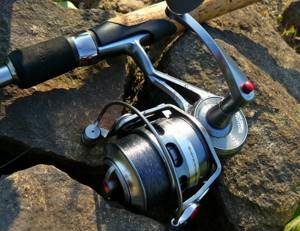
The appearance of a spinning reel is known to every fisherman; because of their appearance, they are also called “meat grinders”.
An inertia-free reel consists of a spool with a line wound on it, a line handle with a roller, a rotating rotor, a body containing the reel mechanism, a handle and a foot of the reel, with which it is attached to the reel seat of the fishing rod.
All spinning reels are equipped with a friction brake, which can be front or rear.
Advantages of spinning reels
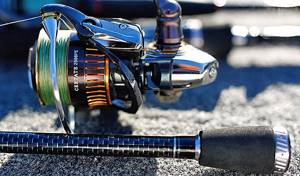
- The advantages of inertialess reels many times exceed their disadvantages:
- Versatile, spinning reel is suitable for different fishing methods: spinning, float fishing, trolling, feeder.
- Manufacturability, manufacturers constantly keep up with the times, reduce the weight of reels, constantly increase their strength and reliability, use modern, innovative materials and technologies.
- Large selection of sizes, gear ratios, materials, prices. Every fisherman can choose a reel that suits his fishing conditions and budget.
- Simplicity of design and ease of use, even for novice anglers.
You may be interested in: Shad wobblers
Disadvantages of spinning reels
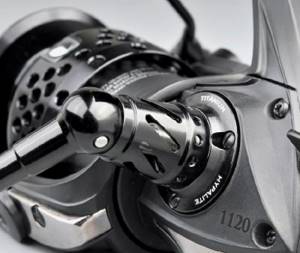
With all the advantages that spinning reels have, we can mention two of their significant disadvantages:
- Price, a good quality spinning reel costs a lot. It is better for a novice fisherman to first purchase a reel from a budget price range, and later, having figured it out and learned how to fish with it, move on to a more serious option.
- The need for careful treatment and care. A modern spinning reel is a technically complex product that requires careful attention and care. If used carelessly and incorrectly, even an expensive and high-quality reel will not last long.
Multiplier reels
Multiplier reels are a slightly more complicated type of regular inertia reel. They can be used for jig-spinning fishing and have both advantages and disadvantages.
The advantage, compared to spinning reels , is their greater sensitivity, which is important for jig fishing, and with a relatively small size they are more powerful. In addition, a high-quality, well-tuned multiplier, when using bait weighing more than 15 grams, allows you to cast quite far, in some cases surpassing even spinning reels. There are also special ones for record casting, which do not structurally provide for the use of a line laying device, which reduces the casting range by 10-15%.
sovetprost.ru
Fishing with a baitcasting reel
But the real strengths of the multiplier appear when fishing for large trophy fish with a spinning rod. After some training with a rod with a weight test of 30 g or more, you will beat any “long-range” spinning reel. However, care should be taken when working with light baits equipped with additional weight. While a spinning reel is generally forgiving of long casts, on a multiplier this leads to nasty beards. Americans call them "bird's nest." It sounds more beautiful than it looks.
About
The Evolution of Fishing Reels
There are 3 types of them in spinning fishing:
- inertial ; these reels appeared as tackle earlier than others and are still used successfully; characterized by a simple design using a rotating drum equipped with a ratchet brake;
- inertialess ; here the line is simply gradually removed from the spool without any rotation, and, therefore, inertia created by the bait during long casting; has long been considered a revolutionary method of spinning fishing;
- cartoon ; It’s interesting that, in essence, this is a return to inertial coils, only in a more complex version; It was like development in a spiral.
Multiplier reel brake
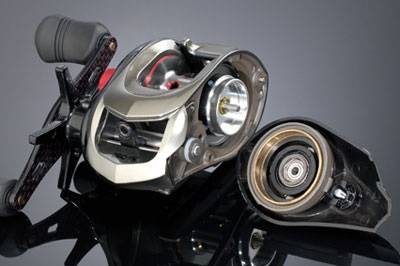
Magnetic braking relies on the braking of a rapidly rotating spool using built-in small magnets.
This type of braking, which operates at the initial stage of casting, must be adjusted manually, based on the weight of the bait used.
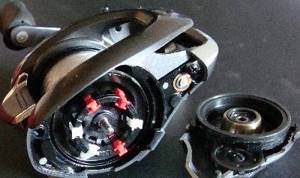
Centrifugal braking is present in another subtype of reels. The main role in them is played by small weights that protrude when the coil rotates quickly due to the action of centrifugal force. Thanks to the friction of these weights against a special partition, the process of gradual braking occurs. As with magnetic braking, centrifugal braking must also be adjusted manually.
A mechanical brake is present in all types of reels and is used at the final stage of casting, when the bait is already touching the water. For long-distance casting, the mechanical brake in the multiplier reel is the most effective.
Spinning reel or multiplier
Today this question faces many fishermen and does not contain a clear answer. Each of these types of coils has its own advantages. For inertialess gear they are:
- ease of casting, skill acquired very quickly;
- the line rarely forms a “beard” even when casting long distances
- light weight;
- fast rewinding, with one turn of the handle you can reel in up to 1 m of fishing line;
- friction brake sensitivity.
The multiplier reel has its advantages:
- casting with its help is also easy;
- such a reel is good when using heavy bait;
- allows the use of thick fishing line;
- Fishing this way is less energy intensive.
Bearings for baitcasting reels
The quantity and quality of bearings plays an extremely important role if you want the reel to run smoothly and serve you for a long time. Due to the small size of the baitcasting reel drum and the gear ratio often reaching a ratio of 6:1, the spool rotates extremely quickly. Therefore, for normal operation and to withstand the load, the reel must have high quality ball bearings.
When purchasing some reels, you will find a tube of special liquid in the kit, which is designed to lubricate the bearings. For the longevity of the reel, it is necessary to periodically lubricate all accessible bearings with such a substance, which will also affect the casting distance. But you should avoid other third-party lubricants and oils.
Which reel is better
Just a few years ago, the owners of multiplier reels seemed almost aliens, and this tackle itself was an unusual curiosity, fun for eccentrics. Now it’s no longer a secret that this type of reel is, in essence, a modified winch .
To understand which reel is better - a multiplier or a spinning reel, you simply need to test them in action , on a specific body of water and when fishing for specific types of fish.
Let’s say, if you are going for a big catch, “mults” give you a feeling of confidence due to the reliability and simplicity of the design. It is believed that this reel can withstand more serious loads . In this case, the problem - a multiplier reel or a spinning reel - is solved in favor of the first.
However, handling baits weighing less than 5 grams is not entirely convenient , and many people find the gear too cumbersome.
When deciding which is better—a multiplier or a spinning reel—many fishermen pay attention to the adjustable brake system in “winch” designs . It seems to work well and reliably, but it has to be adjusted for each type of bait or fish. Not everyone likes this when fishing.
The new generation of gear reels are lighter. But the inertialess one is easier to use. After casting, the multipliers have to be transferred from hand to hand, especially if you are right-handed.
veralline.com
Multiplier reels or spinning reels?
Baiting reels and spinning reels are two types of fishing reels. Multiplier reels A multiplier reel is a more modernized and complex type of inertial fishing reel. As a rule, this is a reel for professional and experienced fishermen. Beginners will find this reel difficult to use as it requires experience and skill. Otherwise, there will be irreversible tangling of the fishing line, the so-called. beards It’s true that removing beards in cartoons is quite simple, but this also requires skill. Multiplier reels are equipped with spool braking mechanisms and a gear mechanism, which allows you to obtain the required retrieving speed when using a small diameter spool. Multipliers designed for casting fishing are usually equipped with a line guide. Externally, multipliers can be compared to small winches. So it is, this type of reel is best suited for catching large fish. Knowing how to use the drag will prevent a big fish from tearing the line. Multipliers are the most reliable and durable type of fishing reels. Pros of baitcasting reels:
- Power
- Reliability
- The line in such reels does not twist
- High sensitivity
- Possibility to use thick lines
- Ability to use heavy attachments
- There are models with a line rewind counter
Disadvantages of baitcasting reels:
- High price
- Requires experience and skills to use
- Inconvenient when using light baits
- Inconvenient when using thin fishing line
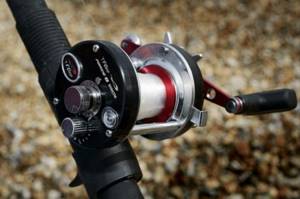
Spinning reels Spinning reels - at the moment this type of fishing reel is the most popular among fishermen. When casting, the line runs off the end of the spool (the axis is located longitudinally to the rod) only in the amount necessary for casting. The fisherman can only return the line-laying arc to its place, making sure that the fishing line hits the line-laying roller. These fishing lines are good because when casting, tangling of the fishing line rarely occurs; experienced fishermen do not develop beards on such reels at all. Pros of spinning reels:
- A beginner quickly masters fishing with this type of reel.
- The line rarely gets tangled
- It is fashionable to fish with both light and heavy baits
- You can fish with a thin line
- You can use almost any technique for placing the bait.
Disadvantages of spinning reels:
- These reels break more often when fishing
- You need to have a spare coil.
- Some models of such reels do not work well with thick fishing line
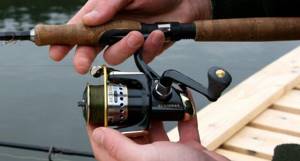
Useful video
Let's look at the video of an expert opinion on the differences between a multiplier reel and a spinning reel:
Summing up the results of this analysis of different types of coils, we can say that the choice here is up to everyone. Both tackles can be used for casting, trolling, and fishing from a boat. Both require skill and ability.
klevyj.com
I don’t know how to use a cartoon for jigs, although I’ve used them a lot, but fishing with “Nelma” inertial reels is possible even with a strong minus... The pluses are sensitivity, and an extreme degree of reliability. The downside is that you need to be able to cast with it. Therefore, for fishing with a jig, and if we fish from a boat, inertia is even in favor. I’ll explain why - you can kill a cartoon with one wrong action - just by starting to drag the fish like on a winch... Over time, the gap between the gears of the GP The cartoon increases, it begins to make a roar, and eventually dies. I had to open the cartoons, based on a complaint - a roar.. I opened it - and there were no teeth at all.. But the reason was a little different - improper lubrication.. As for cold water - something crazy... it’s like a cord should absorb moisture (what kind of cord is it then, you know) so that it reaches our fingers, having time to moisten and cool them... No matter how many times I’ve fished in the cold with multis, this has never happened before I haven’t seen it.. Yes, the fingers feel a certain coldness, but more due to the fact that the blood does not circulate properly (the hand is constantly in one position, it kind of freezes)...+ the cartoon is also picky about the quality of the cord. The inertia engine doesn’t give a damn about all this. The cost of the inertia engine (except for “Nelma”, I don’t see any competitors for it at the moment) fits into the “budget” rank, but at the same time it produces such performance characteristics (THE ONE TRACTION IS WORTH IT!))) that the multiplier with close (I emphasize close, but not identical) performance characteristics would cost under 30 (some kind of sea barrel) and would weigh far from 210g. It would be impossible for them to throw weights at 12 g, and “Nelma” makes it possible to use weights at 8 g...... I won’t say anything about meat grinders at all - with such performance characteristics there is only one meat grinder at Daiva-Saltiga (and even that one is in the old version. About the new one I don’t know) in the amount of 3500 and above. But it all comes down to the price... to give 40 pieces of retail for a saltig, getting far from the same qualities that we get from an inertia - if there is nowhere to put the money, then you are welcome.... the simpler the mechanism, the it is more reliable under extreme loads... You don’t even need to pump out fish up to 5 kg with an inertial action - just reel it in with a reel... The cartoon will not allow this - after 700 g they can only pump... The topic is underdeveloped, and many who tried “Nelma” on a jig no longer take it get your hands on cartoon sets for 30 rubles retail... The good old classic, renewed at the level of modern materials and serving for many, many years... it may be difficult to learn, but you can learn how to throw such tackle during fishing, and it has many advantages. and I didn’t name even 100% of all of them...
hunfis.ru
What to look for when choosing?
Remember that this model has a complex design, which greatly affects the cost. Therefore, when choosing a multiplier, you should not purchase ultra-budget models, so as not to be disappointed.
The main characteristics, requirements for the pond, spinning rod for a multiplier reel are indicated in the accompanying instructions. Make sure the model is suitable for the climate conditions of the region.
Find out what minimum fishing line diameter the multiplier can work with. The smaller the diameter specified, the more variations you will have for line selection. An incorrectly selected fishing line can get stuck in the spool and become damaged. The higher the gear ratio, the less the reel thrust. Values from 4.5 to 5.2 to 1 are suitable.
Low-profile, small-sized multipliers ensure high casting accuracy. When using braid, you should choose a model with a ceramic hole, thanks to which the cord will not fray.
Characteristics
The multiplier operates on the principle of inertia; its structure is somewhat similar to the functioning of a winch. There is a “trigger” located near the holder, which makes it easier to cast with a wrist. There is a bare blank underneath the spool where the ring finger usually sits. This ensures better sensitivity.
The angler can pass the braid through his fingers, which increases sensitivity. At every moment of time, the fisherman knows where the bait is, without even watching it, but by tactile sensations.
Be careful to size your line wisely if you plan to use this method, as too thin a line can cut your fingers.
Types of tactile bait control:
- control of the braid while the bait is falling. The cord passes between the thumb and forefinger;
- Line control all the time while fishing. This method often leads to cuts and is not suitable for everyone.
Application
Multipliers for spinning rods are used for casting fishing from the shore, from a boat, for power fishing in a plumb line or by trolling.
For the multiplier to work for a long time, you need to know the rules of its maintenance. Before installing a new model, you need to wipe all its elements with a flannel cloth moistened with kerosene. This is necessary to get rid of excess grease.
In order to set up the multiplier before fishing: unscrew the spool, wipe the ends and support bearings. If the design includes magnetic brakes, then excess must also be removed from them.
Wiping should be done after every fishing. If sand gets into the worm gear located under the line guide, it should be cleaned and then lubricated. After fishing, we loosen the clutch, and before starting fishing, set it to working condition.
Tips for a newbie:
- We select the braid depending on the weight of the bait. Braid with a diameter of less than 0.3 mm is effective for baits weighing up to 15 g. From 0.3 to 0.4 mm - 15−30 g; 0.4 mm - 30−40 g;
- The cord should be soft and round in shape. This is necessary to reduce windage, that is, increase the casting distance, as well as increase the sensitivity of the tackle;
- When choosing braid, give preference to aluminum oxide inserts. Sometimes monofilament lines are suitable.
Fishing line for baitcasting reel
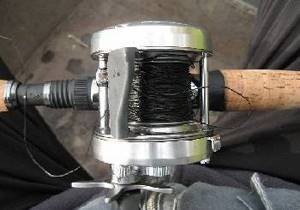
Any reel is characterized by the presence of a certain threshold for the length of the fishing line, as well as a frame for its diameter. When using a line thinner than what is provided for a specific reel model, it may get caught in the small gap between the spool and the body itself. In the opposite case, that is, when using too thick a fishing line, problems with braking may arise, and as a result, injury to the reel.
Types of multipliers
Coils are divided into two types:
- low-profile - used for light baits and small-diameter fishing lines. They are distinguished by a long casting range;
- “barrels” are classic baitcasting reels with a high profile, used for medium and large-sized baits. They have increased power and are used in power fishing.
For power fishing
Power fishing reels are used in sea fishing. They are distinguished by a low gear ratio and high power. Power multipliers are effective for landing fish weighing over 5 kg.
Low profile baitcasting reels
Low profile, small size reels provide better casting accuracy and distance. They are used for light baits, thin braids or fishing lines. They are light in weight and have the line layer close to the blank. Casts reach over 50 meters, a good choice for fishing from the shore.
Types of baitcasting reels
- Low profile (soap dishes) are suitable for baits weighing from 1 to 30 grams.
- Barrel-shaped (weight of baits: 7-60 grams).
- Power (marine)
Power multipliers are divided into the following subtypes:
- Trolling (lure weight from 40 to 200 grams)
- For vertical fishing (lure weight up to 600 grams)
- Heavy duty multipliers (for very large fish)
If you are going to fish on a river, then you need a low-profile baitcaster that weighs little and casts baits far. For particularly heavy lures, such as jerkbaits, a small barrel reel may be suitable. Other types of multipliers are intended for sea or trolling fishing.

If you are catching large catfish from a boat, you can also take marine variants of multipliers, as they can withstand a greater load.
Trolling reels have a counter to measure the length of the spooled fishing line. Such a counter is necessary for deepening wobblers to the required depth. First, the bait is lowered to a specific depth, the counter value is recorded, and then the line is lowered exactly to this value.
Trolling reels are also more expensive than conventional multipliers. Therefore, if the budget does not allow you to purchase a trolling reel, but there is a need for a counter, you can use a traditional multiplier and a regular marker, which you will use to make marks on the fluorescent fishing line. Next, we will consider the technical features of multiplier reels.
Advantages and disadvantages
Advantages of fishing with a multiplier:
- When fishing, the reel is located directly in the palm of your hand. The tackle is more balanced and sensitive, in comparison with the inertialess one;
- small total weight of the spinning rod set, about 300 grams;
- the spool is close to the blank, the rings are set low;
- ease of manipulation with wobblers;
- the line does not twist, as it goes straight to the spool;
- casting range does not depend on the thickness of the fishing line;
- working with baits of different weights.
Disadvantages of fishing with a baitcasting reel:
- price;
- time to master casting techniques;
- fishing with ultralight baits is not as effective as inertialess bait;
- relatively low speed of winding the line onto the spool;
- impossibility of use at temperatures below zero.
Brake
Braking during casting is carried out due to a friction clutch consisting of metal plates, fluoroplastic and a braking system. The friction clutch is needed when playing fish; it is located on the handle and is structurally designed in the form of an asterisk.
Types of brake systems:
- magnetic braking;
- centrifugal mechanical braking;
- combined.
The braking system serves to reduce the inertia of the drum during casting. Typically, models with mechanical braking have 6 weights that can be activated all at once or one at a time. The number of weights included depends on the weight of the bait.
The magnetic braking system is suitable for light baits when the load on the reel is light. It is easier to regulate, but does not perform well with medium and large baits.
Each model is equipped with an axial brake, which is activated before the bait splashes down.
Disadvantages of baitcasting reels:
- High price;
- The need to use a fishing rod that has an upper arrangement of rings;
- The need to reposition the rod when casting;
- Adjusting the braking system when fishing conditions change;
- The need for careful care and delicate operation.
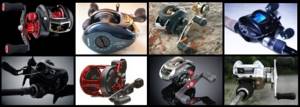
If you are interested in the topic of spinning reels, we recommend our main review of spinning reels.
